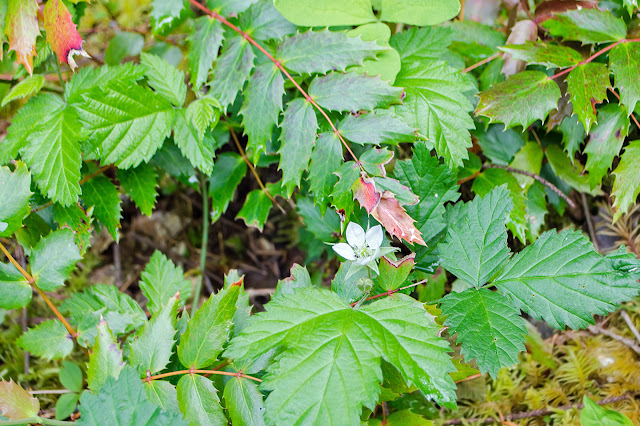The Ripple Rock trail brochure classifies the trail as "Easy to Moderate". It's 8 kilometres, round trip, and takes from 2.5 to 3 hours. Yesterday, I made a second attempt at it, this time with my energetic granddaughter. I made it halfway, and turned back, to rest at the first viewpoint while she went on to the bottom of the last hill.
It's not an easy hike, although it seems so at first, where a wide road leads down, down, down to the shore at Menzies Bay. There, the trail turns and clambers up a narrow rock staircase of sorts, steep, uneven, twisty and sometimes wobbly underfoot. After a couple of bridges and more hills, we come to a viewpoint; a wide, flattish rock at the top of a cliff, carpeted with moss, dotted with flowers. We went on. The trail drops and rises, drops again. I was starting to stumble.
By the time I had given up and returned to the viewpoint, I was out of breath and a bit dizzy. (I'm not as young as I used to be, but then, who is?) I lay flat on the moss, recovering, and watched the clouds.
 |
| The view from moss level. |
 |
| Cottony clouds and the treetops. |
Later, I sat on a rocky outcrop, snacking on nuts and apricots, watching flowers blow in the wind. And then a bird, a big bird, appeared between two trees, soared away off down the bay, came back with a couple of friends. They spiralled across the water, almost at my feet for a long while.
At first, I thought they were young eagles. But the wings weren't right.
 |
| Turkey vulture. The head is small, because it lacks feathers. When the light was right, I could see that it was red. And the wings are turkey vulture wings. |
The wing itself is dark, but the flight feathers are pale. Against the bright sky, the light shines through them.
 |
| The red head is visible here. The bill is white, and hooked. |
Later, while we had lunch on the rock, the birds joined the flock at the mouth of the bay. Too far away for photos, but I took a few anyhow; couldn't resist. And when I examined those photos at home, I discovered the imposters.
 |
| 6 vultures here. But if you look closely (Click for a full-size photo), you'll discover three double-winged fliers joining the flock. Dragonflies! |
Distances are deceptive; the dragonflies were probably just at the edge of our cliff.
(The trail hasn't beaten me; I'll tackle it another day, more slowly. There's no reason I have to go end to end without stopping to rest, is there?)
Another
Skywatch post.























































